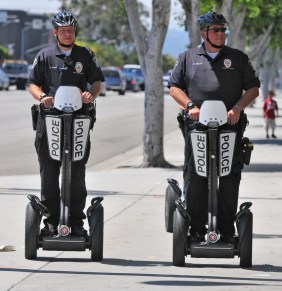
The inventor of the Segway is Dean Kamen. In 2001, Dean introduce the Segway personal transporter and explained the name Segway derived from the word segue, which means a smooth transition.
Law enforcement and security companies immediately adopted the new technology for testing and evaluation. More than 1,500 police and public safety organizations across the globe are now using Segway’s as part of their patrolling strategies in an effort to enhance mobility and visibility in the communities they serve.

The Segway can travel up to a speed of 12.5 mph and that is about the average speed of a human sprinting.
Advantages of the Segway Patrol
- Maneuverability
- Airport Duty
- Campus Patrol
- Visibility
- Approachability
- Walking Path Patrols
- Shopping District Patrol
- Mobility
- Responsiveness
- Versatility
- Green eco-friendly machine

Delray Beach hopes to add two more Segways for police patrol
Segway donated to Torrington Police Department
GR Police To Patrol Downtown On Segways
Police use Segway to enhance Haneda airport security

Along with any new technology, training and familiarity increases knowledge for safely operating and maximize the potential of Segway patrols.
The Segway can enhance foot patrol areas and reduce officer fatigue. The Segway has limited storage space; however, it does allow patrol officers an opportunity for extra equipment and gear that they otherwise could not carry on a standard foot patrol assignment.
Cost and service is always something to consider when adopting new patrol strategies.
Each department will have to decide if adding a small fleet of Segway’s is beneficial for their jurisdiction responsibilities and service to their community.

About the Author
Mark Bond has worked in law enforcement and has been a firearms instructor for more than 33 years. His law enforcement experience includes the military, local, state and federal levels as a police officer and criminal investigator. Mark obtained a BS and MS in criminal justice, and M.Ed in educational leadership with Summa Cum Laude honors. As a lifelong learner, he is currently pursuing a doctoral degree in education (EdD) with a concentration in college teaching and learning. Mark is currently an assistant professor of criminal justice at a university and adjunct professor of administration of justice studies at a community college.

